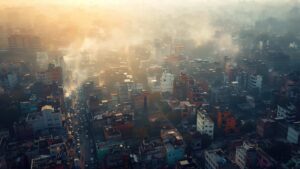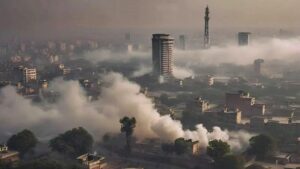An analysis of the pollution crisis in Lahore shows that the city is the most polluted in the world, with an AQI of 394. Lahore has continuously battled rising pollution levels in recent years, but in 2024 it achieved a sobering level by being named the most polluted city in the world. The city is currently dealing with the urgent problem of air pollution, which has a daily impact on millions of citizens.
Numerous reasons, including industrial activity, agricultural practices, rising urbanization, and weather patterns that trap toxins in the air, have contributed to this regrettable position of the most polluted city.
Nonetheless, in 2024, there are 14,407,000 people living in the Lahore metro region. Such massive population is living in such toxic environment full of toxins and harmful chemicals.
An Overview of the Dangerous Pollution Levels in Lahore

With an alarming Air Quality Index (AQI) of 394, this major city of Pakistan has now acquired the unsettling title of the most polluted city in the world. With an AQI rating much over the “very unhealthy” standard (AQI above 150), this level categorizes the air quality as hazardous and poses serious health hazards to all people.
Furthermore, the concentration of air pollutants, such as nitrogen dioxide (NO2), ozone (O3), fine particulate matter (PM2.5), and coarse particles (PM10), is measured by the AQI. The current AQI of 394 in Lahore indicates hazardous pollution levels that have caused numerous health issues, including coughing, eye discomfort, skin infections, and trouble breathing.
Certainly, this is an unhealthy number of toxins included in the air that impact people in many ways. The people of Lahore suffer grave health consequences as a result of the fog. Prolonged exposure to pollutants increases the hazards for vulnerable groups, such as children, the elderly, and people with underlying cardiovascular or respiratory disorders.
Nonetheless, there is a need for immediate action to take a sensible decision for the environment of the city, especially in light of highlighted symptoms such as respiratory distress, frequent coughing, eye irritation, and general discomfort that are connected to Lahore’s pollution levels.
Key Elements contributing to Pollution of Lahore

There are two main causes of the city’s pollution problem:
Crop Residue Burning: Burning agricultural waste generates loads of smoke and fine particles into the environment, especially during harvest season.
Industrial Emissions: The city’s already high pollution levels are worsened by factories and vehicle exhaust, which leads to dangerous air conditions and growing fog.
Nonetheless, several measures have been implemented by the Punjab government in response to the smog situation in Lahore. Recently, Senior Minister Marriyam Aurangzeb announced the formation of an “Anti-Smog Squad,” which will reduce Lahore pollution by doing the following:

Farmer Education: The team will inform farmers about the risks associated with burning crop residue and provide safer substitutes. Super seeders, which make it easier to dispose of leftovers without burning, are one example of an environmentally beneficial technique that farmers are being urged to use.
Monitoring and Enforcement: Members of the Anti-Smog Squad are armed1 with cars to patrol smog-affected areas, warn people, and put an end to crop burning. This program is a component of a larger “zero-tolerance” strategy on the causes of air pollution.
Environmental Curriculum: To raise awareness from an early age, environmental protection has also been included in the provincial curriculum.
Furthermore, The Punjab administration intends to use artificial rain as an emergency solution to disperse pollutants and lessen the intensity of the smog to momentarily relieve the dangerous air. The goal of this action, which is still in the planning stages, is to temporarily lower the concentration of particulates in the air.
The Punjab government’s smog-fighting plan is expected to produce observable outcomes in the ensuing eight to ten years. To provide a cleaner, healthier environment for the people of Lahore, the government has declared a “war on smog” and mobilized resources from a variety of sectors. Residents are also urged to report smoke sightings by calling a specific helpline (1373), which guarantees that Anti-Smog Squads will respond promptly.
Nonetheless, the pollution problem in Lahore has intensified to previously unheard-of proportions, endangering the public’s health.
If continued and widely embraced, the anti-pollution programs have the potential to significantly improve the lives of city inhabitants while preserving Lahore’s environmental future and public health.
It will take extensive and consistent work from the public and government organizations to address this complicated issue. Solutions like encouraging the use of cleaner energy sources, funding public transit, and implementing more strict environmental laws might have a big impact. But it will take time to reverse the effects of decades of urban pollution, so quick action is needed to protect public health and improve air quality in one of Pakistan’s liveliest cities Lahore.













